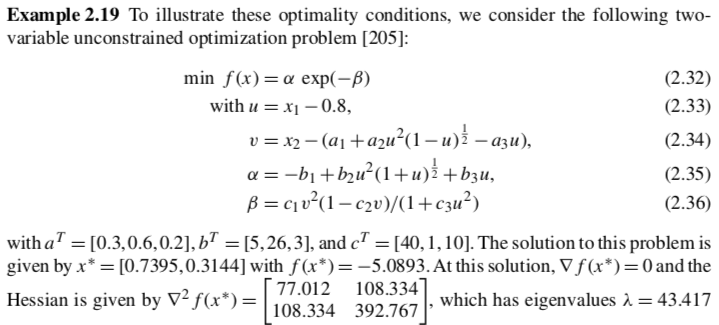import matplotlib.pyplot as plt
import numpy as np
from scipy import linalg
from mpl_toolkits.mplot3d import Axes3D
from matplotlib import cm
Main Idea: Use the necessary and sufficient conditions to classify a candidate solution.

## Define Python function
def my_f(x,verbose=False):
''' Evaluate function given above at point x
Inputs:
x - vector with 2 elements
Outputs:
f - function value (scalar)
'''
# Constants
a = np.array([0.3, 0.6, 0.2])
b = np.array([5, 26, 3])
c = np.array([40, 1, 10])
# Intermediates. Recall Python indicies start at 0
u = x[0] - 0.8
s = np.sqrt(1-u)
s2 = np.sqrt(1+u)
v = x[1] -(a[0] + a[1]*u**2*s-a[2]*u)
alpha = -b[0] + b[1]*u**2*s2+ b[2]*u # September 5, 2018: changed 's' to 's2'
beta = c[0]*v**2*(1-c[1]*v)/(1+c[2]*u**2)
f = alpha*np.exp(-beta)
if verbose:
print("##### my_f at x = ",x, "#####")
print("u = ",u)
print("sqrt(1-u) = ",s)
print("sqrt(1+u) = ",s2)
print("v = ",v)
print("alpha = ",alpha)
print("beta = ",beta)
print("f(x) = ",f)
print("##### Done. #####\n")
return f
## Define candidate point and check against value reported in book
xtest = np.array([0.7395, 0.3144])
ftest = my_f(xtest)
print("f(x*) = ",my_f(xtest),"\n")
## Make 3D plot to visualize
x1 = np.arange(0.0,1.1,0.05)
x2 = np.arange(0.0,1.0,0.05)
# Create a matrix of all points to sample
X1, X2 = np.meshgrid(x1, x2)
n1 = len(x1)
n2 = len(x2)
# Notice the order. This was wrong in quadratic.ipynb and has been corrected in quadratic_update.ipynb
F = np.zeros([n2, n1])
xtemp = np.zeros(2)
# Evaluate f(x) over grid
for i in range(0,n1):
xtemp[0] = x1[i]
for j in range(0,n2):
xtemp[1] = x2[j]
F[j,i] = my_f(xtemp)
# Create 3D figure
fig = plt.figure()
ax = fig.gca(projection='3d')
# Plot f(x)
surf = ax.plot_surface(X1, X2, F, linewidth=0,cmap=cm.coolwarm,antialiased=True)
# Add candidate point
ax.scatter(xtest[0],xtest[1],ftest,s=50,color="green",depthshade=True)
# Draw vertical line through stationary point to help visualization
# Maximum value in array
fmax = np.amax(F)
fmin = np.amin(F)
ax.plot([xtest[0], xtest[0]], [xtest[1], xtest[1]], [fmin,fmax],color="green")
plt.show()
f(x*) = -5.089256907976166
Discussion: Based on the 3D plot, is this function convex?
We need the calculate $\nabla f(x)$ and $\nabla^2 f(x)$ to analyze a given point. Below are functions that implement a central finite difference. Another option it to analytical calculate the derivatives or use automatic differentiation.
## Gradient
def my_grad(x,verbose=True):
'''
Calculate gradient of function my_f using central difference formula
Inputs:
x - point for which to evaluate gradient
Outputs:
grad - gradient (vector)
Assumptions:
1. my_f is defined
2. input x has the correct number of elements for my_f
3. my_f is continous and differentiable
'''
eps = 1E-6
n = len(x)
grad = np.zeros(n)
if(verbose):
print("***** my_grad at x = ",x,"*****")
for i in range(0,n):
# Create vector of zeros except eps in position i
e = np.zeros(n)
e[i] = eps
# Finite difference formula
my_f_plus = my_f(x + e)
my_f_minus = my_f(x - e)
# Diagnostics
if(verbose):
print("e[",i,"] = ",e)
print("f(x + e[",i,"]) = ",my_f_plus)
print("f(x - e[",i,"]) = ",my_f_minus)
grad[i] = (my_f_plus - my_f_minus)/(2*eps)
if(verbose):
print("***** Done. ***** \n")
return grad
grad = my_grad(xtest)
print(grad)
***** my_grad at x = [0.7395 0.3144] ***** e[ 0 ] = [1.e-06 0.e+00] f(x + e[ 0 ]) = -5.089256904035737 f(x - e[ 0 ]) = -5.089256911839596 e[ 1 ] = [0.e+00 1.e-06] f(x + e[ 1 ]) = -5.089256892701673 f(x - e[ 1 ]) = -5.089256922857939 ***** Done. ***** [0.00390193 0.01507813]
Discussion: According to the book, $\nabla f(x_{test}) = 0$. Is the above answer reasonable?
Note: Before fixing the mistake in my_f, the gradient was [-0.28182046 0.01506107]. The version we discussed in class had the mistake in my_f.
## Hessian
def my_hes(x):
'''
Calculate gradient of function my_f using central difference formula and my_grad
Inputs:
x - point for which to evaluate gradient
Outputs:
H - Hessian (matrix)
Assumptions:
1. my_f and my_grad is defined
2. input x has the correct number of elements for my_f
3. my_f is continous and twice differentiable
4. No mistakes in my_grad
'''
eps = 1E-6
n = len(x)
H = np.zeros([n,n])
for i in range(0,n):
# Create vector of zeros except eps in position i
e = np.zeros(n)
e[i] = eps
# Evaluate gradient twice
grad_plus = my_grad(x + e,verbose=False)
grad_minus = my_grad(x - e,verbose=False)
# Notice we are building the Hessian by column (or row)
H[:,i] = (grad_plus - grad_minus)/(2*eps)
'''
Note: This is not very efficient. You can probably this of several
performance improvements. We will learn more practical ways to approximate
the Hessian for optimization algorithms in the next few lectures.
'''
return H
H = my_hes(xtest)
print(H)
[[ 76.99973992 108.3413359 ] [108.3413359 392.7191905 ]]
Primary Discussion: How does this compare to the answer given in the book? Which elements are very close to the given answer? Which have greater error? Why does this make sense?
Secondary Discussion: What happens if you set eps to different values in my_grad and my_hes? Is H still symmetric?
Activity
Answer Yes, No, or Possibly for each bullet point.
# YOUR SOLUTION HERE
[ 43.39788177+0.j 426.32104865+0.j]